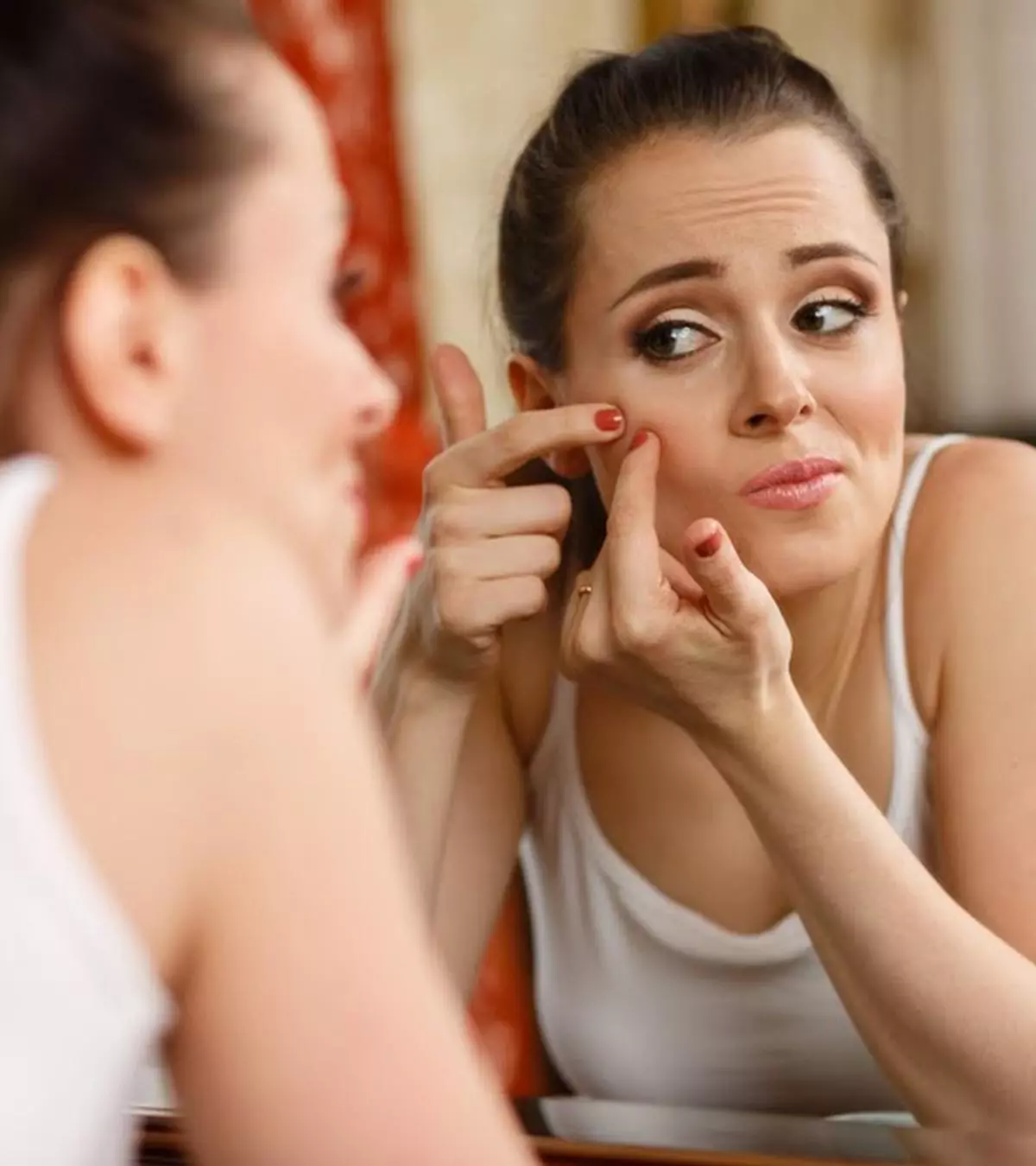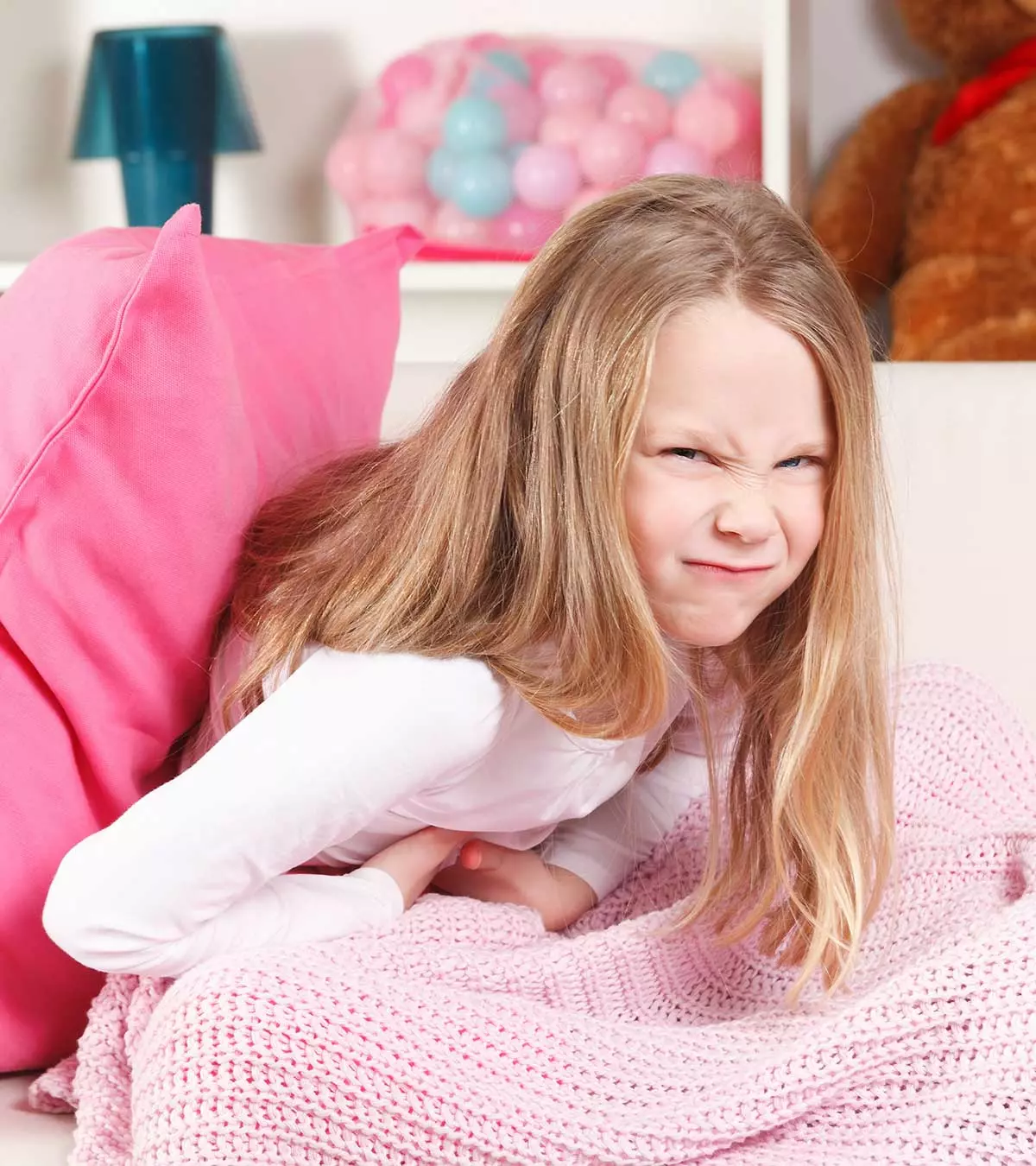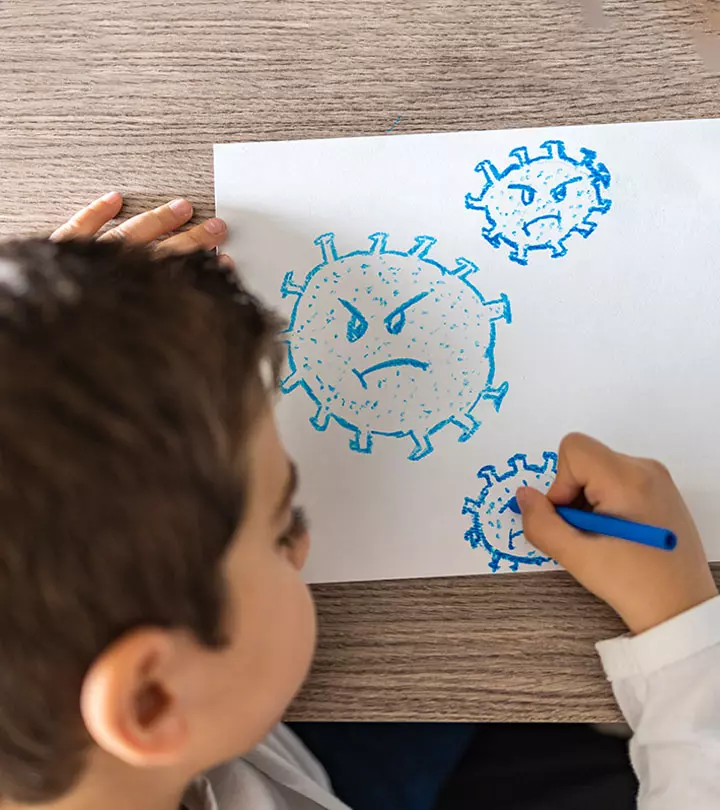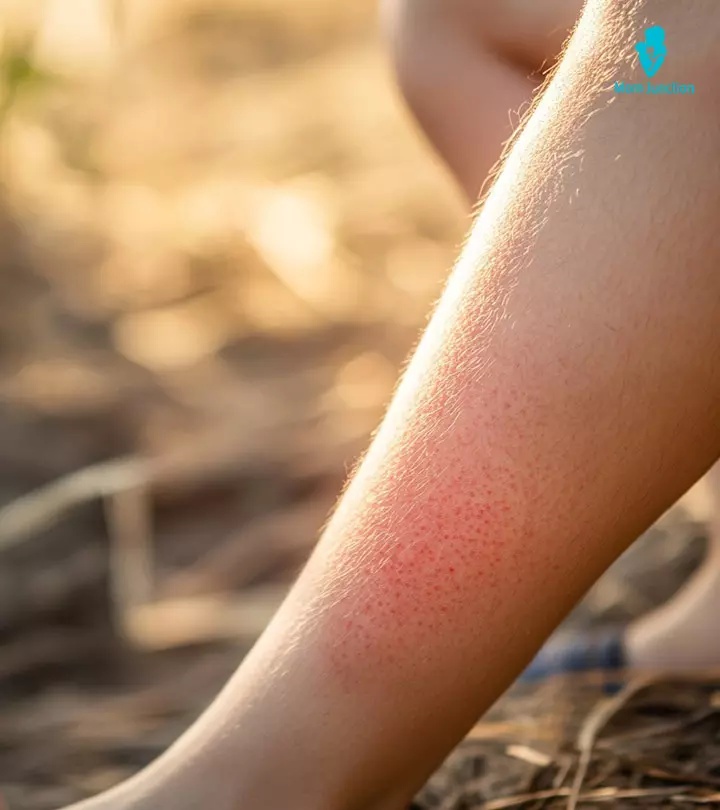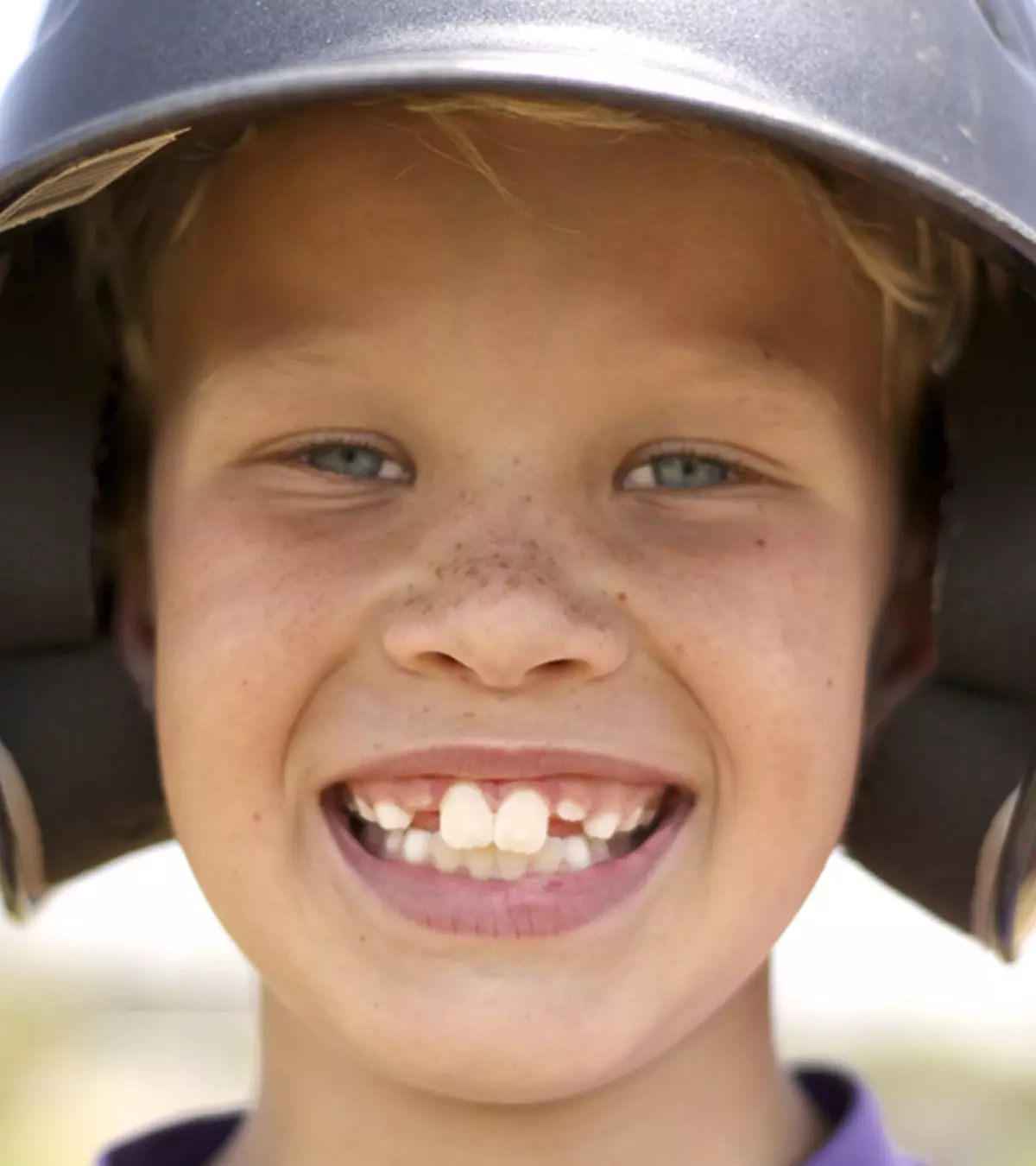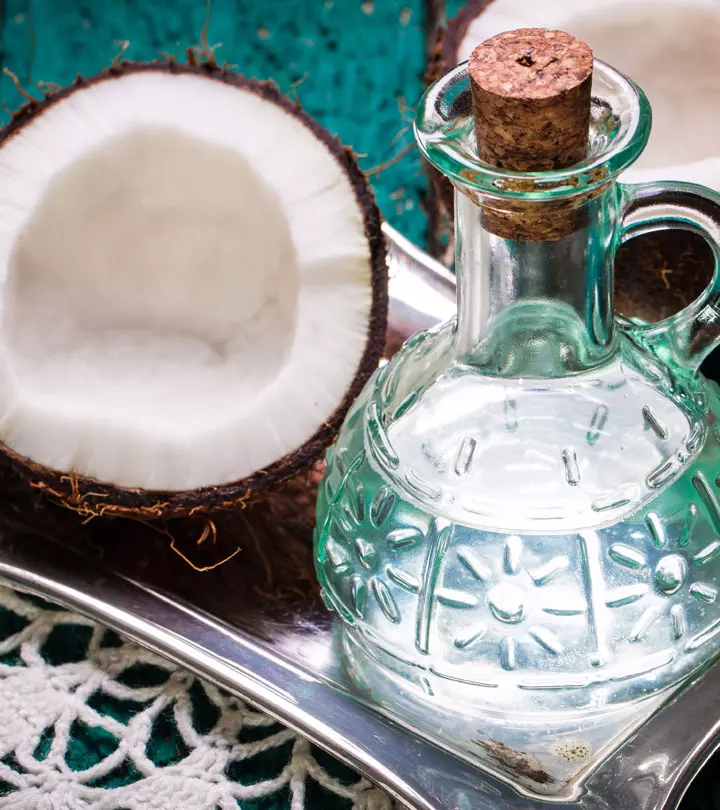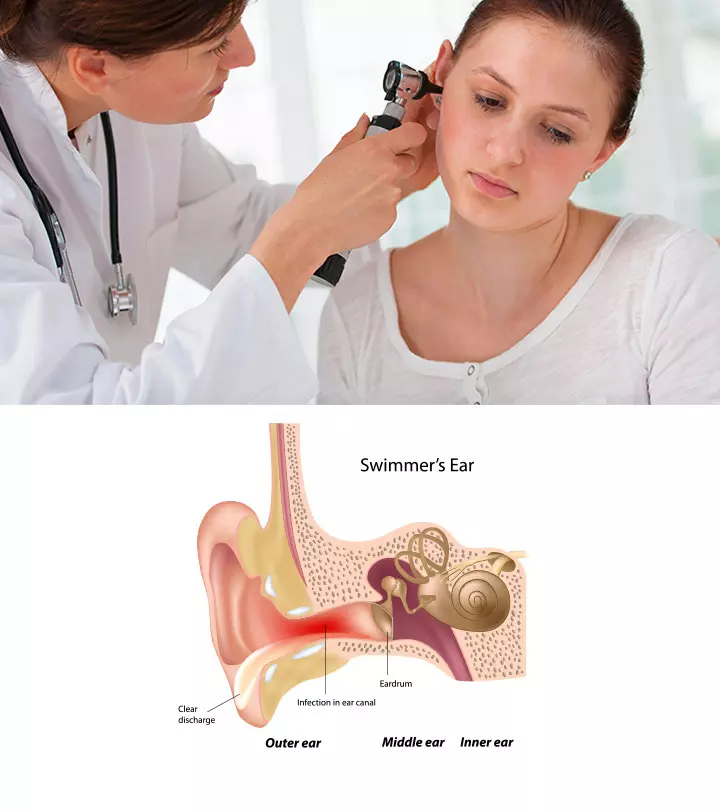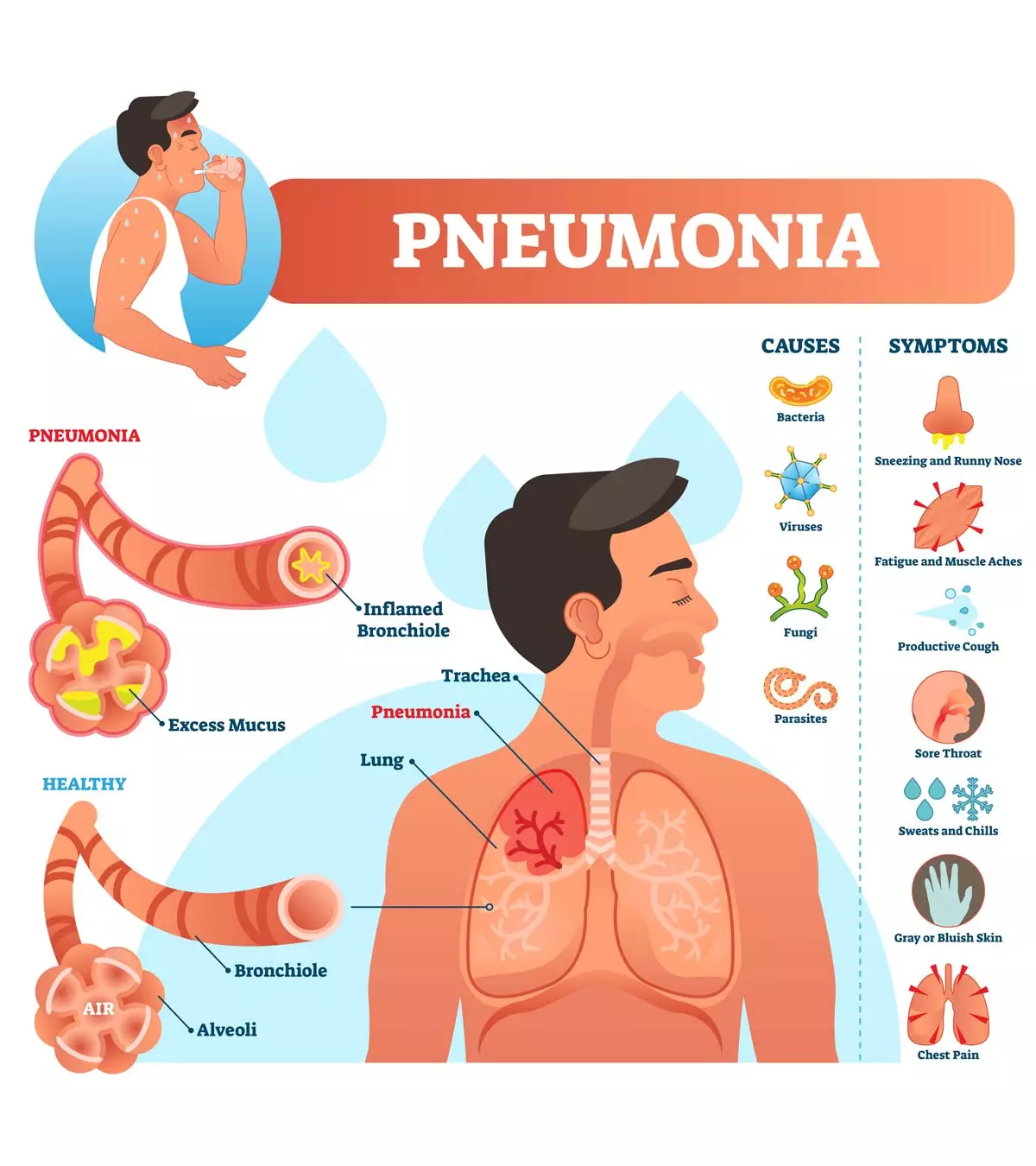
Image: Shutterstock

Gallstones or cholelithiasis are pebble-like, solid deposits formed by the solidification of digestive fluids in the gallbladder (1). The complex interplay of environmental and genetic factors causes gallstones in children.
Children with a positive family history and certain inherited disorders are more likely to develop gallstones. Childhood obesity and certain medications may also increase the risk. Gallstones are painless and asymptomatic in most cases. However, inflammation and pain may occur if the stone blocks the flow of digestive juices, such as from the pancreas (2).
Read on to know about possible causes, symptoms, risk factors, treatment, and prevention of gallstones in children.
Key Pointers
- Gallstones may form inside the gallbladder due to excess cholesterol and bilirubin or inadequate emptying of the gallbladder.
- Obesity, family history, rapid weight loss, or diseases that cause excess red blood cell breakdown increase the risk of gallstones in children.
- Indigestion and abdominal pain may be caused initially, which may be accompanied by jaundice, diarrhea, and fever.
What Causes Gallstones In Children?
Gallstones form in the gallbladder, a small, sac-like organ present below the liver. The gallbladder stores bile (a digestive juice produced by the liver) and releases it into the duodenum (part of the small intestine) after meals to aid digestion. However, this process doesn’t work smoothly in some cases, leading to gallstones’ development due to the following reasons (1) (3).
- Cholesterol supersaturation: The liver excretes cholesterol, which it dissolves into bile. However, if cholesterol excretion increases, the bile may contain a concentrated amount of dissolved cholesterol. The excess cholesterol precipitates, leading to the formation of cholesterol crystals. These crystals gradually fuse into yellowish-green cholesterol gallstones over time.
- Excess bilirubin: Bilirubin is a yellow-colored by-product of red blood cells (RBCs) breakdown, which occurs inside the liver. The liver recycles bilirubin by using it as an ingredient in bile. However, certain blood disorders could concentrate the amount of bilirubin in bile. The high amount of bilirubin could eventually lead to the formation of gallstones. These are known as pigment gallstones, which are the most common type of gallstones found in children.
- Gallbladder hypomotility: The gallbladder may sometimes not empty adequately. It could cause bile stagnation, which may lead to gallstones formation over time. Insufficient bile salts within the gallbladder could also lead to gallstones’ development.
An individual can have cholesterol or bilirubin stones or a mix of both types. Gallstones can be as tiny as a sand grain or as big as a golf ball (4).
What Are The Risk Factors For Gallstones In Children?

Image: Shutterstock
In most pediatric cases, there’s no definitive cause for gallstone formation. Some factors may put a child at a higher risk of gallstone development (5) (6).
- Overweight and obesity: Research shows that overweight and obese children are twice more likely to develop gallstones than their normal or underweight counterparts. Girls are at higher risk of developing gallstones than boys (7) (8). High cholesterol in the bile and abnormal gallbladder functions could cause gallstone formation in obese individuals (9).
- Hereditary: The risk of gallstone development is twice higher if an individual has a family history of gallstones (10). The risk may increase with environmental factors, such as a high-fat diet and obesity. Gallstones due to genetic factors are more common in teens (11).
- Inherited red blood cell disorders: Inherited red blood cell disorders, such as sickle cell anemia and spherocytosis, could increase the risk of gallstone development in children (12). In sickle cell disease, an excess breakdown of red blood cells could lead to increased levels of bilirubin. It could eventually increase the risk of pigment gallstones (13).
- Rapid weight loss: Fasting for long durations and losing weight too fast could cause the liver to release extra cholesterol into the bile. It may also prevent the gallbladder from emptying properly, increasing the risk of gallstone formation. Older children and teens should avoid crash diets, which raises the risk of gallstone formation (9).
Certain health conditions, such as Crohn’s disease and inflammatory bowel disease, some medications, abdominal surgery, and prolonged intravenous feeding, may also increase the risk of gallstones in children and teens.
What Are The Symptoms Of Gallstones In Children?

Image: Shutterstock
Gallstones may not always cause symptoms. If gallstones block the cystic duct, it can cause an accumulation of bile within the gallbladder. This condition is known as a gallbladder attack or biliary colic, which could lead to the following symptoms (1) (3) (14).
- Pain in the upper right abdomen, which may spread to the back or shoulders. It can feel like sharp or dull cramping pain that fluctuates and gets worse after ingesting fatty and greasy foods. It may last from 30 minutes to several hours and generally happen after meals, especially during the night (15).
- Dyspeptic symptoms, such as belching, bloating, abdominal discomfort, heartburn, and indigestion in children are common gallstone symptoms due to the obstruction of bile flow.
These symptoms may come and go when the gallstones move and the cystic duct unblocks. However, if the gallstones obstruct the bile flow for more than a few hours or move into other organs, such as the pancreas, it may cause complications with the following symptoms (4).
- High-grade fever, i.e., 38°C (100.4°F) or above
- Yellowing of the skin and whites of the eyes (jaundice)
- Diarrhea or light-colored stools and tea-colored urine
- Intense shivering and chills
- Rapid heartbeat
- Nausea and vomiting
A woman, now 40, reflects on her experience with gallstones during her teenage years. She recounts, “When I was 16 years old, I got more yellow than I had ever been and I had a lot of stomach pains. After a lot of tests, they found out that I had gallstones. They were taken out in the same year as my final exams. Thankfully, this surgery was also successful and I could do my exams after all (i).”
A study examined the medical records of 188 children who had presented with symptomatic cholelithiasis (gallstones) over 15 years. It noted that most children displayed peak symptoms at around the age of 17 years. This was consistent across boys and girls. The incidence of gallstone presentations increased among girls after the age of 11 years.

Gender and age-based distribution of incidence of gallstone presentations
Source: Adolescent gallstones—need for early intervention in symptomatic idiopathic gallstones; Pediatric Surgery InternationalGallstone symptoms are similar to those that occur in other gastrointestinal problems. Therefore, consult a pediatrician to determine the underlying cause.
How Are Gallstones Diagnosed In Children?
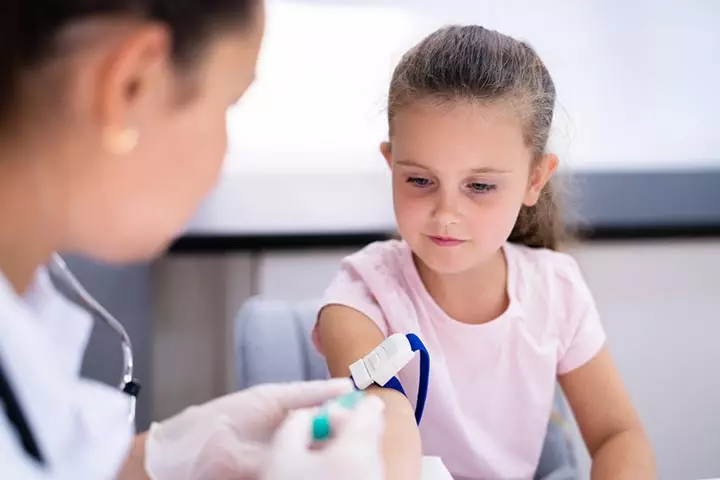
Image: Shutterstock
A doctor will note the child’s family, medical, and diet history. Based on their evaluation, they may refer you to a gastroenterologist who would do the following tests (16) (17).
- Physical exam: During the physical exam, the doctor will examine the child’s abdominal area superficially and check for the pain location. They will also inquire about symptoms, such as the frequency, severity, duration of the pain, and suspected triggers, such as heavy, high-fat meals.
- Blood tests: After a physical exam, the doctor may use blood tests to determine liver function. These blood tests determine infection and inflammation in the liver, gallbladder, bile ducts, and pancreas.
- Imaging tests: Ultrasound imaging is a standard, non-invasive tool to confirm the presence of gallstones. The ultrasound scan uses high-frequency sound waves to image the gallbladder and gallstones. Additional scans, such as a cholescintigraphy or HIDA scan, may be advised if the bile duct’s obstruction is suspected. Computed tomography (CT) scan may be done in an emergency to determine the cause of severe abdominal pain.
Based on the diagnosis, the doctor will prescribe a suitable treatment plan for the child.
 Quick fact
Quick factHow Are Gallstones Treated?
Asymptomatic or silent gallstones usually do not require any treatment. Painful and symptomatic gallstones could be treated with the following treatment methods (17) (18).
1. Nonsurgical methods

Image: Shutterstock
A doctor may use nonsurgical methods to eliminate cholesterol gallstones. Some of these methods are:
- Oral dissolution therapy uses medicines to break down, dissolve, and remove the stones. Medicines, such as ursodiol (actigall) and chenodiol (chenix), containing bile acids, are used for the treatment. These medicines are slow-acting and may take several months or years to work.
- Lithotripsy uses shock waves to break gallstones into smaller pieces. This treatment method is used rarely and often with oral dissolution therapy.
Although these treatment modalities remove stones, they can’t prevent a recurrence. Regular treatment and observation might be needed in some cases.
2. Surgical methods
Surgical methods could be considered for the removal of gallstones. If a child experiences severe symptoms or other treatment methods do not provide sustained relief, surgical removal of the gallbladder (cholecystectomy) is the only alternative treatment. Below are the surgical techniques that a doctor may consider.
- Endoscopic retrograde cholangiopancreatography (ERCP): This technique uses a combination of endoscopy and x-rays or fluoroscopy. The doctor puts an endoscope with tiny lights and a camera into the upper digestive system through the mouth to locate and remove gallstones. The doctor may use additional instruments to address any blockage or infection. It is a preferred procedure for pediatric patients since it involves a shorter stay at the hospital.
- Laparoscopic cholecystectomy: Laparoscopic surgery or keyhole surgery is a minimally invasive technique to remove the gallbladder. In this method, a few small holes are made into the abdomen to insert a camera and surgical instruments. The gallbladder is then removed through the holes. It is the preferred method of removing the gallbladder in children since it causes less pain and involves shorter hospitalization time.
- Open cholecystectomy: Severe gallbladder inflammation, infection, or gallstones accompanied by the unusual anatomy of the common bile duct, may require open cholecystectomy. The procedure involves a large incision on the abdominal cavity for the removal of the gallbladder. The child may have to stay a few days to up to a week after the procedure.
The course of treatment would depend on the intensity of pain and the size of the gallstones. The doctor may recommend dietary changes, such as avoiding fatty foods, along with treatment.
Once the gallbladder is removed, the bile will directly flow from the liver to the duodenum. A child may observe minor changes, such as soft or loose stools for a short time. However, it usually does not cause any long-term side effects.
What Are The Possible Complications Of Gallstones?
If gallstone symptoms are left unattended, they may lead to a series of complications, such as (1) (19):
- Acute cholecystitis: It occurs when the cystic duct becomes permanently blocked, leading to bile build-up in the gallbladder. The build-up of bile can infect and inflame the gallbladder causing symptoms, such as severe pain in the upper abdomen, high-grade fever, and a rapid heartbeat. Severe infection may cause the gallbladder to burst, thus inflaming the inner lining of the abdominal cavity.
- Choledocholithiasis: It is a condition in which the gallstone passes through the cystic duct and lodges into the common bile duct. A child with choledocholithiasis shows symptoms, such as jaundice, dark brown urine, clay-colored stools, and appetite loss. In some cases, the stone may move from the bile duct, and bile flow is re-established. But in case it doesn’t, stone removal becomes necessary.
- Acute cholangitis: It is the infection of the blocked bile ducts. A child with bile duct infection is likely to have symptoms, such as pain in the upper abdomen that travels towards the shoulder blade, a high fever, jaundice, chills, and feeling of being unwell. In such cases, antibiotics will treat the infection, and the ERCP will drain bile from the liver.
- Acute pancreatitis: It is the blockage of the pancreatic duct due to gallstones. Its most common symptom is a sudden sharp to dull pain or cramping in the upper abdomen’s center. The pain gradually worsens after eating. A child with acute pancreatitis may feel sick and experience loss of appetite, high fever, diarrhea, and abdomen tenderness. There is no cure for acute pancreatitis. Subsiding the inflammation through pain relief medicines and nutrition support can provide relief.
- Gallstone ileus: In rare cases, the large gallstones perforate the gallbladder wall and create an abnormal channel or fistula between the gallbladder and the small or large intestine. It causes bowel obstruction, which develops gallstone ileus symptoms, such as swelling and pain in the abdomen, the feeling of sickness, and constipation. This condition warrants prompt treatment due to the high risk of a ruptured bowel, which could cause internal bleeding and infection.
Gallstones could rarely cause gallbladder cancer. A family history of gallstones and high levels of calcium in the gallbladder could increase the risk.
The complications of gallstones tend to be uncommon since children are likely to report symptoms, such as pain and discomfort, much before the development of complications.
 Be watchful
Be watchfulCan You Prevent Gallstones In Children?

Image: Shutterstock
There is no definite method to prevent gallstones. Parents could lower their child’s risk of developing gallstones by mitigating the risk factors through the following steps (20).
- Motivate your child to maintain a healthy weight by indulging in 60 minutes or more of moderate-to-vigorous intensity physical activity every day (21). Excess weight, especially around the abdominal area, is a risk factor for gallstone formation.
- Guide children to eat a well-balanced diet and teach them to limit the intake of foods high in saturated fats. Red meat, sausage, butter, lard, ghee, hard cheese, and processed foods, such as biscuits and cookies, are sources of cholesterol that raise the risk of gallstone development.
- Encourage children to eat fiber-rich foods, such as whole-grains, raw fruits and vegetables, and seeds.
- Guide to stay away from artificial drinks, such as cola and sweetened fruit juices, containing refined sugar, which causes unwanted weight gain.
- Teach children to read food labels and eat foods with less or no refined carbohydrates and trans fats. Fried and processed foods are high in trans fats.
- Promote healthy fats’ ingestion by serving healthy foods, such as tuna, nuts, and seeds.
Frequently Asked Questions
1. Are gallstones serious?
Asymptomatic gallstones are not usually serious. However, if too many stones accumulate in the gallbladder or block the bile duct, they can cause pain and lead to serious outcomes (22).
2. Is cholelithiasis common in children?
No, gallstones are usually more common among those older than 20 years (23). However, the increased prevalence of risk factors, such as obesity, has led to cases among children as well (24).
3. Can children have gallbladder disease without gallstones?
Yes, there could be cases where children may develop gallbladder inflammation without gallstones (25).
4. Can my child with gallstones drink milk?
Yes, you may serve low-fat or no-fat milk and dairy products to a child with gallstones (26).
Obesity in childhood, family history, genetic red blood cell abnormalities, and certain drugs may increase the risk of gallstones in children. While gallstones presented with no symptoms may not require treatment, they can cause stomach discomfort and dyspeptic symptoms once ruptured. They may then require treatment to alleviate symptoms and prevent complications. Gallbladder removal may be recommended in most cases, which does not result in long-term complications since one can lead a regular life without a gallbladder. Further, avoiding fatty meals and refined sugar and eating fiber-rich foods may help prevent gallstones in children.
Infographic: What Are The Signs Of Gallstones In Children?
From hereditary factors to being overweight or losing too much weight, children can develop gallstones due to several causes. While, many times, they remain asymptomatic, bile accumulation due to a blocked cystic duct may cause gallstones to present with symptoms. Check out the infographic below to learn about these symptoms.
Some thing wrong with infographic shortcode. please verify shortcode syntaxIllustration: Symptoms Of Gallstones In Children And Its Complications
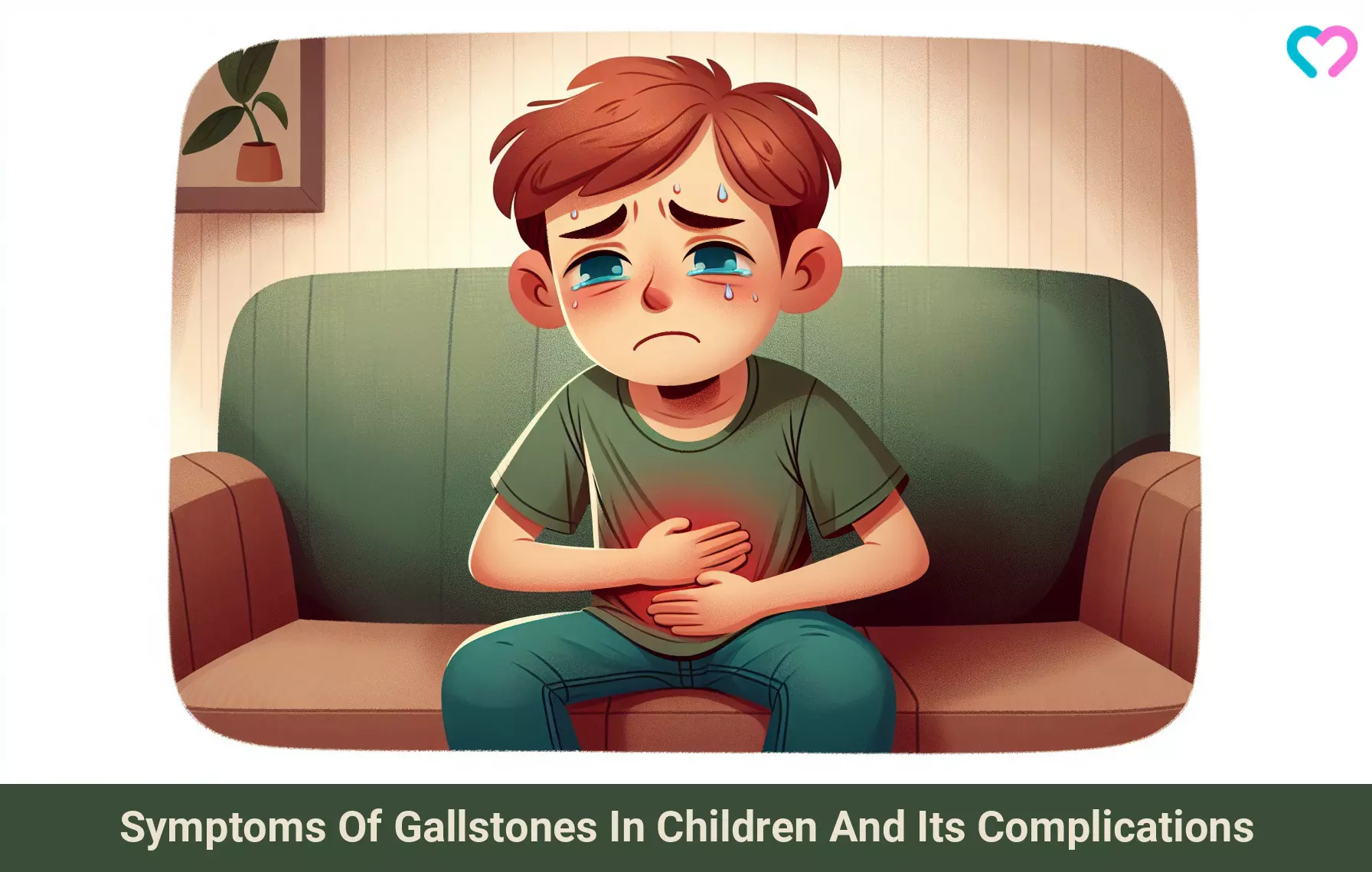
Image: Dall·E/MomJunction Design Team
Watch this interesting video discussing pediatric gallstones and robotic surgery. Discover how this cutting-edge technology can help your child get the best care possible.
Personal Experience: Source
MomJunction articles include first-hand experiences to provide you with better insights through real-life narratives. Here are the sources of personal accounts referenced in this article.
i. Personal stories;https://pyruvatekinasedeficiency.com/personal-testimonials/
References
1. Jasmin Tanaja et al., Cholelithiasis; NCBI
2. Gallstones; Boston Children’s Hospital
3. Gallstones and Gallbladder; Nicklaus Children’s Hospital
4. Gallstones, Symptoms; NHS
5. Gallstones; GI Kids & NASPGHAN
6. Gallstones; Seattle Children’s
7. Corinna Koebnick et al.; Pediatric obesity and gallstone disease: results from a cross-sectional study of over 510,000 youth; NCBI
8. Barbora Frybova et al.; Cholelithiasis and choledocholithiasis in children; risk factors for development; PLOS
9. Dieting & Gallstones; National Institute of Diabetes and Digestive and Kidney Diseases
10. Gilat et al.; An Increased Familial Frequency of Gallstones; Gastro Journal
11. Hasan Karami et al.; Cholelithiasis in Children: A Diagnostic and Therapeutic Approach; Researchgate
12. Ahmed H. Al-Salem; Cholelithiasis and Choledocholithiasis; Springer Link
13. Gallstones and sickle cell disease; St. Jude Children’s Research Hospital
14. Symptoms & Causes of Gallstones; National Institute of Diabetes and Digestive and Kidney Diseases
15. Gallstones; Johns Hopkins Medicine
16. Diagnosis of Gallstones; National Institute of Diabetes and Digestive and Kidney Diseases
17. Gallstones; NHS
18. Treatment for Gallstones; National Institute of Diabetes and Digestive and Kidney Diseases
19. Complications; NHS
20. Eating, Diet, & Nutrition for Gallstones; National Institute of Diabetes and Digestive and Kidney Diseases
21. Physical Activity for Children: An Overview; CDC
22. Gallstones: what happens when they cause pain and discomfort; Top Doctors UK
23. Sridhar Chilimuri et al; Symptomatic Gallstones in the Young: Changing Trends of the Gallstone Disease-Related Hospitalization in the State of New York: 1996 – 2010; National Library Of Medicine
24. Gallstones; Seattle Children’s Hospital
25. Gallbladder Disease in Children; Healthy Children
26. Low-Fat Diet for Gallbladder Disease: Care Instructions; Kaiser Permanente
Community Experiences
Join the conversation and become a part of our nurturing community! Share your stories, experiences, and insights to connect with fellow parents.
Read full bio of Dr. Anuradha Bansal
Read full bio of Sravani Rebbapragada
Read full bio of Dr. Ritika Shah
Read full bio of Dr. Joyani Das





